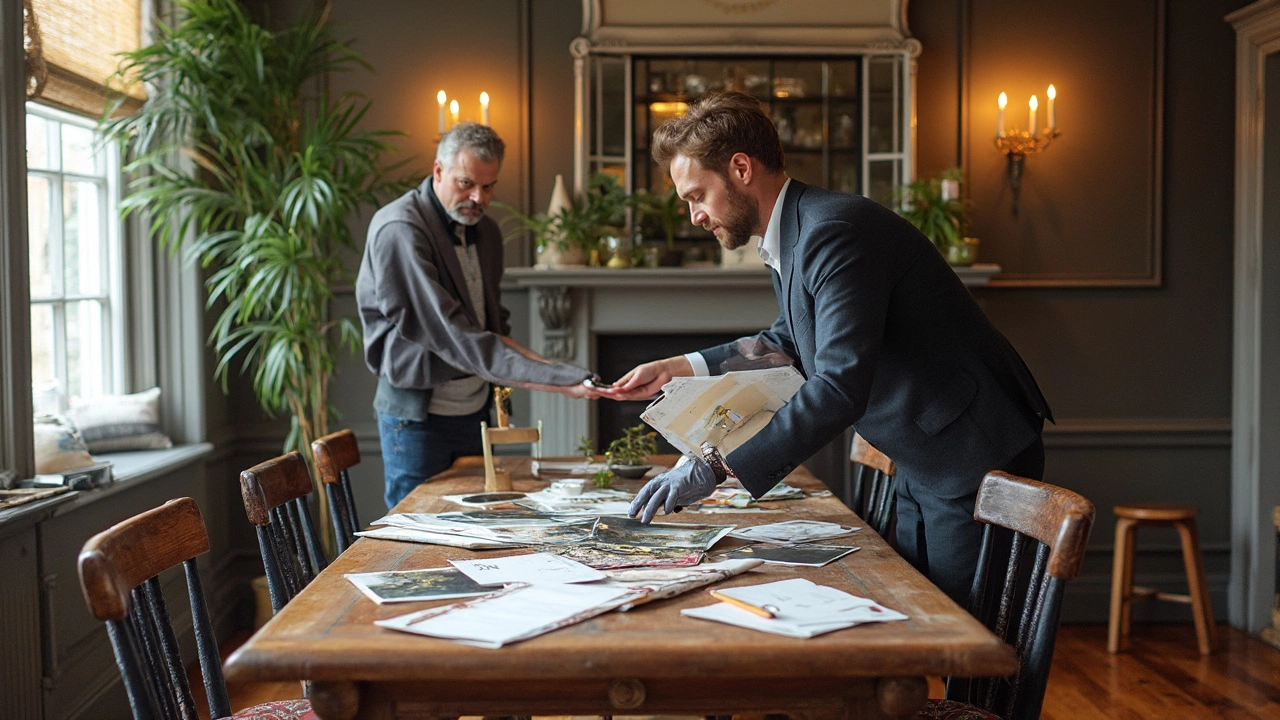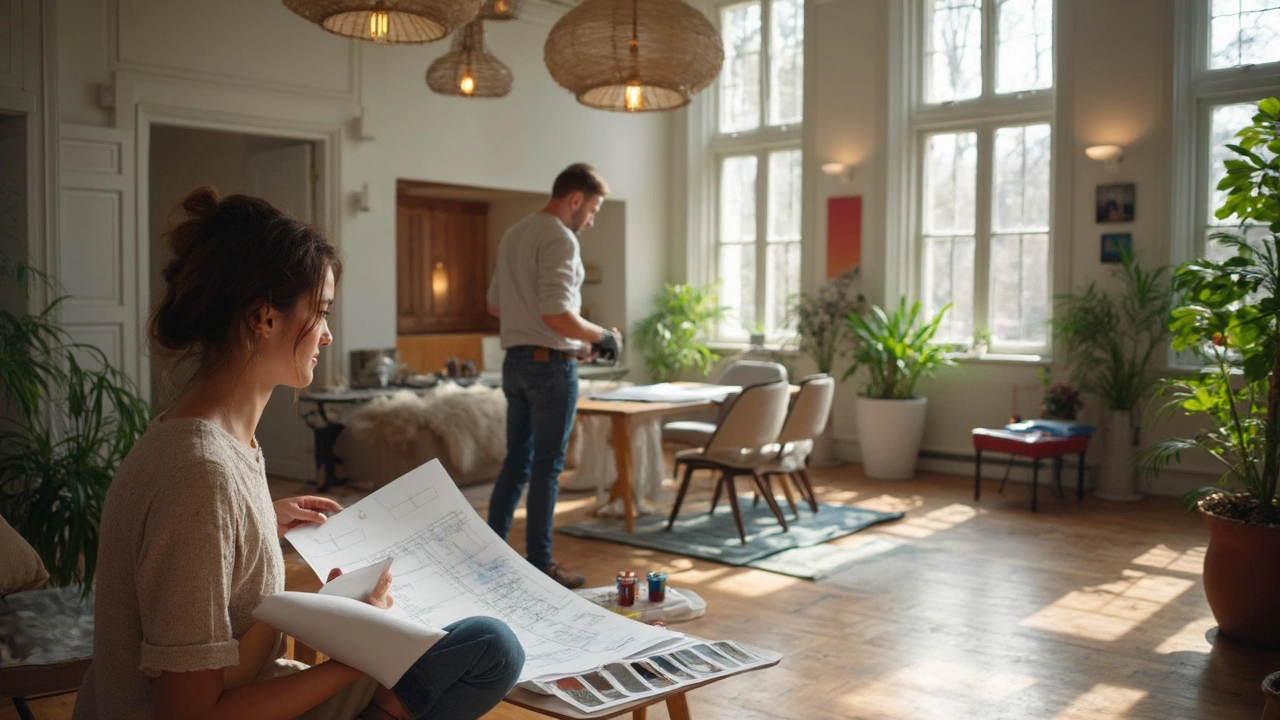Most folks think an interior designer just comes in, hangs a few pictures, fluffs up some cushions, and calls it a day. That's not even close. Decorating is just a slice of what interior designers actually do, and if that's all you expect, you're missing out on a ton of useful stuff they bring to the table.
These pros are trained to figure out how rooms work best—not just how they look. Ever wondered why some spaces just feel good to be in? There's science behind that, and interior designers know it. They plan everything from the layout and traffic flow to lighting and even where your electrical outlets go, way before picking out paint.
- More Than Just Decoration
- The Designer's Toolbox: Skills and Services
- When and Why to Hire an Interior Designer
- Tips for Working with Designers
More Than Just Decoration
Thinking a interior designer just picks out curtains and throws is missing the point. They actually get involved way before the 'pretty stuff' happens. Most designers start with a deep dive into how you live—how many people use the space, what your daily routine looks like, and even whether you have pets or need space for kids’ toys. They’re solving real life problems, not just color-matching pillows.
Ever noticed open floor plans feel brighter and easier to navigate? That’s not an accident. Interior designers study the flow between rooms. They create layouts that help you move easily, make the best use of natural light, and ensure you’re not bumping into awkward furniture as you walk through the house.
There’s also safety and health to consider. Designers follow building codes, work with electricians and plumbers, and watch out for things like proper ventilation, non-slip surfaces, and safe lighting. And they often catch stuff that can trip you up later—like electrical outlets in the right place so you’re not running cords everywhere, or making sure there’s enough clearance for opening doors and drawers.
- They read and create blueprints so contractors know exactly what to build
- They select durable, family-proof materials for floors and furniture
- They help with lighting plans—not just fixtures, but how light impacts your mood and productivity
- They plan storage solutions for things you probably haven’t even thought about
Designers are also pros at stretching a budget. According to a 2023 HomeAdvisor report, hiring a designer can save homeowners up to 10-15% on overall renovation costs by helping avoid expensive mistakes and re-dos. So while decorating is the fun part, it’s just a fraction of what goes into real interior design.
The Designer's Toolbox: Skills and Services
People throw around the term interior designer and think it's all about picking out furniture. In reality, these pros come packed with skills that go way beyond matching patterns and choosing couches. They're trained in space planning, building code regulations, lighting design, and project management. If you’ve ever tried to design a room that works for both a busy family and a pet, you know that good design is part science, part people skills.
Most certified interior designers go through years of education—sometimes a four-year degree in interior design or architecture. Many take the NCIDQ (National Council for Interior Design Qualification) exam, which covers not just color theory, but stuff like building codes, accessibility (think wheelchair-width doorways), life safety, and environmental sustainability. If you thought choosing throw pillows was the hard part, that’s just the frosting.
Here’s the kind of work you can actually expect from a real interior designer:
- Space planning: Deciding where walls, doors, and furniture should go so you don’t trip over something every time you walk in. This includes floor plan drawings that help contractors know exactly what’s up.
- Project management: Juggling schedules, budgets, contractors, and vendors so your renovation doesn’t turn into a second job for you.
- Lighting plans: Figuring out where lights, switches, and outlets go for mood, function, and safety. Ask anyone who’s tried to read in a dark room how important that is.
- Material selection: Choosing finishes and coverings (like flooring and countertops) that look good and actually fit your lifestyle (no white sofas for three toddlers, please).
- Building code knowledge: Keeping your remodel legal and safe, especially if you’re adding a bathroom or moving walls.
- Custom solutions: Designing built-in storage, clever shelving, or nooks that actually fix problems instead of just covering them up.
It helps to think of a home design pro as part creative, part technical expert, and part therapist. They listen to what you need, translate your budget into workable plans, handle a pile of paperwork and technical drawings, and bring in the right people to make things happen.
| Role | Designer | Decorator |
|---|---|---|
| Education & Licensing | Usually yes, with certificates or degrees | Not required |
| Can Move Walls/Add Plumbing | Yes | No |
| Focus | Function & Form | Style & Aesthetics |
| Project Management | Yes | Rarely |
So, next time you hear 'do interior designers just decorate?' you'll know—they do all this, and plenty more you don’t see!

When and Why to Hire an Interior Designer
So, when should you call in a interior designer? Honestly, more situations than you might guess. It's not just for fancy mansions or celebrity homes. If you're knocking down walls, moving into a new place, or even renovating a single room, that's prime time to bring in their expertise. They don't just pick colors—they help you avoid costly mistakes and make sure your space works for your lifestyle.
One of the biggest reasons people hire designers is to save time and stress. There are hundreds of decisions to juggle in even a basic remodel. Do you really want to spend your weekends hunting for tile samples? A designer manages all those details and keeps you from getting overwhelmed.
And let's talk about money. Designers often get access to trade discounts—sometimes up to 20-40% off retail—so their fees can actually pay for themselves. If you're working on a budget, they’ll help you spend smarter, not just more. According to a Houzz survey from 2023, 54% of homeowners said hiring a pro helped them avoid expensive do-overs.
| Common Reasons People Hire Interior Designers | Potential Benefits |
|---|---|
| Full-home renovations | Professional planning, fewer mistakes |
| Kitchen or bath remodels | Better layouts, maxed-out storage |
| New construction | Optimized floor plans from the start |
| Moving into a new house | Personalized style, streamlined unpacking |
| Staging a home to sell | Increased sale price, faster process |
Here are a few clear signs you should think about hiring a interior designer:
- You want your space to work better, not just look good.
- You’re about to make a big investment and want to get it right the first time.
- You’re too busy to handle endless choices or chase down contractors.
- You want access to products or services not available to the public.
- You keep getting stuck or frustrated when picking design elements.
Bottom line: It’s not just about pretty things. It’s about getting a home that looks great, feels right, and actually fits how you live. Interior designers can make that happen a lot faster—and sometimes for less than what you’d spend doing it all yourself.
Tips for Working with Designers
Working with an interior designer isn't just about handing them the keys and waiting for the big reveal. If you want the best result, a real partnership is the way to go. Here’s how you can make the most of your experience:
- Be clear about your needs and budget. The more honest you are up front, the smoother things run. Designers can get creative even with small budgets, but they need to know your limits. According to the American Society of Interior Designers, over 60% of project issues could be avoided if everyone agreed on a budget at the start.
- Collect inspiration. Gather photos, swatches, and even Pinterest boards—anything that shows off what you like (or really don't like). A visual collage is way easier for an interior designer to understand than just words.
- Ask questions. Don’t be shy. Whether it’s about their past work, their process, or why they're choosing a certain sofa, just ask. Designers appreciate people who want to understand how it all works.
- Communicate openly. Feedback is everything. Don’t say you love something if it’s just “meh.” If you’re not vibing with their picks, let them know early on.
- Trust their expertise—but set boundaries. A home design expert will bring ideas you might never have considered, but it's still your house. Don’t be afraid to say no to anything that feels off. At the same time, if a designer gives you a good reason for a choice, hear them out—sometimes their reasoning can save you money or headaches down the line.
One more thing—find out how fees work before signing anything. Some interior designers charge by the hour, others by the project, and some have purchasing discounts they pass on to you. Here’s a quick snapshot:
| Fee Type | How it Works |
|---|---|
| Hourly Rate | Pay for the time spent working on your project. Great for small jobs. |
| Flat Fee | One set price for the whole job, no matter how long it takes. |
| Percentage | Designer charges a percent of the total cost of your interior design project (usually 10-20%). |
| Cost Plus | You get designer’s trade discounts on products, and pay a markup (often 10-30%). |
Remember, good communication is everything. If a problem pops up—and it will, that's just how home design projects go—deal with it head on. Designers appreciate honesty and teamwork, and you’ll both end up happier with the finished space.
 EN
EN
 HR
HR
 AR
AR

